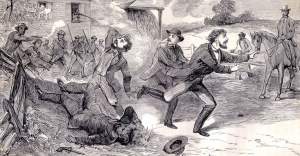| Trial of Henry W. Allen, U.S. Deputy Marshall, for Kidnapping, with Arguments of Counsel & Charge of Justice Marvin, on the Constitutionality of the Fugitive Slave Law, in the Supreme Court of New York. Syracuse, NY: Power Press of the Daily Journal Office, 1852. |
View Record |
| Baker, H. Robert. The Rescue of Joshua Glover: A Fugitive Slave, the Constitution, and the Coming of the Civil War. Athens: Ohio University Press, 2006. |
View Record |
| Bearse, Austin. Reminiscences of Fugitive-Slave Law Days in Boston. Boston: Warren Richardson, 1880. |
View Record |
| Brandt, Nat, and Yanna Brandt. In the Shadow of the Civil War: Passmore Williamson and the Rescue of Jane Johnson. Columbia, SC: University of South Carolina Press, 2007. |
View Record |
| Craft, Ellen, and William Craft. Running a Thousand Miles for Freedom; or, the Escape of William and Ellen Craft from Slavery. London: William Tweedie, 1860. |
View Record |
| Desmond, Jerry R. "The Attempt to Repeal Maine's Personal Liberty Laws." Maine History 37, no. 4 (1998): 194-209. |
View Record |
| Finkelman, Paul. "Prigg V. Pennsylvania and Northern State Courts: Anti-Slavery use of a Pro-Slavery Decision." Civil War History 35 (1979): 5-35. |
View Record |
| Forbes, Ella. "'By My Own Right Arm': Redemptive Violence and the 1851 Christiana, Pennsylvania Resistance." Journal of Negro History 83, no. 3 (1998): 159-167. |
View Record |
| Forbes, Ella. "But We Have No Country: The 1851 Christiana, Pennsylvania, Resistance." Pennsylvania Magazine of History and Biography 123, no. 3 (1998): 248-250. |
View Record |
| Gara, Larry. "The Fugitive Slave Law in the Eastern Ohio Valley." Ohio History 73, no. 2 (1963): 116-128. |
View Record |
| Gara, Larry. "The Fugitive Slave Law: A Double Paradox." Civil War History 10, no. 3 (1964): 229-240. |
View Record |
| Hensel, William Uhler. The Christiana Riot and the Treason Trials of 1851: An Historical Sketch. Lancaster, PA: The New Era Printing Company, 1911. |
View Record |
| Jackson, Ruby West, and Walter T. McDonald. Finding Freedom: The Untold Story of Joshua Glover, Runaway Slave. Madison: Wisconsin Historical Society Press, 2007. |
View Record |
| Johnson, Linck C. "'Liberty Is Never Cheap': Emerson, 'The Fugitive Slave Law,' and the Antislavery Lecture Series at the Broadway Tabernacle." New England Quarterly 76 (December 2003): 550-592. |
View Record |
| Katz, Jonathan. Resistance at Christiana: The Fugitive Slave Rebellion, Christiana Pennsylvania, September 11, 1851: A Documentary Account. New York: Cromwell, 1974. |
View Record |
| Landon, Fred. "Anderson Fugitive Case." Journal of Negro History 7, no. 3 (1922): 233-242. |
View Record |
| Landon, Fred. "The Negro Migration to Canada After the Passing of the Fugitive Slave Act." Journal of Negro History 5, no. 1 (January 1920): 22-36. |
View Record |
| Leddy, Chuck. "Boston Combusts: The Fugitive Slave Case of Anthony Burns." Civil War Times 46, no. 3 (2007): 50-55. |
View Record |
| Levy, Leonard W. "Sims' Case: The Fugitive Slave Law in Boston in 1851." Journal of Negro History 35 (January 1950): 39-74. |
View Record |
| Maginnes, David R. "The Case of the Court House Rioters in the Rendition of the Fugitive Slave Anthony Burns, 1854." Journal of Negro History 56 (January 1971): 31-42. |
View Record |
| May, Samuel J. The Fugitive Slave Law and Its Victims. New York: American Antislavery Society, 1856. |
View Record |
| Preston, Emmett D. "The Fugitive Slave Acts in Ohio." Journal of Negro History 28, no. 4 (1943): 422-477. |
View Record |
| Shapiro, Samuel. "The Rendition of Anthony Burns." Journal of Negro History 44 (January 1959): 34-51. |
View Record |
| Shipherd, Jacob R., Ralph Plumb, and Henry Everard Peck. History of the Oberlin-Wellington Rescue. Boston: John P. Jewett and Company, 1859. |
View Record |
| Smith, Earl. "William Cooper Nell on the Fugitive Slave Act of 1850." Journal of Negro History 66 (1981): 37-40. |
View Record |
| Spooner, Lysander. A Defence for Fugitive Slaves against the Acts of Congress of February 12, 1793, and September 18, 1850. Boston: Bela Marsh, 1850. |
View Record |
| Varon, Elizabeth R. Disunion!: The Coming of the American Civil War, 1789-1859. Chapel Hill: University of North Carolina Press, 2008. |
View Record |
| Yanuck, Julius. "The Garner Fugitive Slave Case." Mississippi Valley Historical Review 40, no. 1 (June 1953): 47-66. |
View Record |































